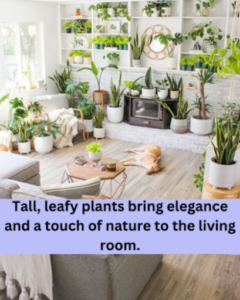In today’s fast-paced world, it’s important to create spaces that promote relaxation and well-being. One way to achieve this is by incorporating plants into your living room decor.
Not only do plants add a touch of natural beauty, but they also bring numerous health benefits. However, arranging plants in a living room requires thoughtful consideration to create a harmonious and balanced atmosphere.
In this article, we will explore various tips and strategies to help you arrange plants in living room, transforming it into a serene oasis that nurtures both your physical and mental well-being.
Assessing Available Space :

Before diving into arranging plants, take a moment to assess the available space in your living room. When arranging house plants, consider the shape and size of each plant to create a balanced composition in your living room .
To create a tidy and visually pleasing living space, it’s important to organize plants in a systematic manner. Consider the layout, lighting conditions, and available surfaces like windowsills, shelves, tables, and floor space.
Understanding these factors will help you determine the types and sizes of plants that will thrive in your living room. By thoroughly assessing the available space, you can determine the optimal locations for your plants.
To effectively organize plants in your living room, start by categorizing them based on their care requirements, such as light and water needs.
This will help you select plants that can thrive in the lighting conditions, find suitable surfaces for their placement, and create a balanced and visually pleasing arrangement.
Remember to consider the maintenance aspect as well, ensuring that the chosen locations allow for easy watering, pruning, and care routines.
To create a vibrant and inviting atmosphere , it’s great idea to place plants in living room.
Selecting the Right Plants :


Choosing the right plants is crucial to ensure their well-being and to complement your living room’s aesthetics. Consider factors such as light levels, temperature, humidity, and maintenance requirements.
Opt for plants that are suitable for the available lighting conditions. This method is used by pros who know very well about expert techniques and methods to arrange plants in living room, Low-light plants like pothos or snake plants are great for areas with limited natural light, while succulents thrive in bright, indirect light.
To create a soothing and inviting atmosphere, it’s essential to arrange plants in the living room, strategically placing them to maximize their visual impact and create a harmonious environment.
Some plants require more attention, such as frequent watering or pruning, while others are more lowmaintenance.
Choose plants that align with your ability to care for them, ensuring they can thrive in your living room without excessive maintenance.
Hanging plants can be a beautiful and space-saving way to place plants in living room.
Creating Levels and Grouping :


Arranging plants at varying heights creates visual interest and adds depth to your living room. Combine floor plants with hanging or wall mounted plants to maximize vertical space.
Place taller plants behind furniture or in corners, while shorter plants can be displayed on tables or shelves. Group plants with similar care requirements to simplify maintenance and create a cohesive look.
Keep plants in living room and enjoy the benefits of aromatherapy by choosing fragrant plants such as lavender or jasmine . By incorporating plants of varying heights, you can utilize the vertical space in your living room.
Taller plants can be placed behind furniture, in corners, or on plant stands to create a sense of verticality. This adds depth to your space and draws the eye upward, making the room feel more expansive.
The art of how to arrange plants in living room lies in finding the perfect balance between greenery and space, creating a captivating display that enhances the overall aesthetic appeal of the room. Hanging plants can be a beautiful and space-saving way to place plants in living room.
Incorporating Planters and Containers :
Planters and containers play a vital role in enhancing the overall aesthetic appeal of your living room. Choose containers that complement your decor style, such as sleek and modern pots for contemporary settings or rustic terracotta pots for a bohemian touch.
Consider the color, texture, and size of the containers to ensure they harmonize with the surrounding elements. It is important to keep plants in living room to enhance indoor air quality by purifying the air and increase oxygen levels.
The size of the planters and containers should be proportionate to the size of your plants and the available space. By incorporating various sizes and types of plants, you can arrange plants in living room to create depth and texture, transforming it into a vibrant and refreshing sanctuary.
Consider the mature size of your plants and ensure that the containers provide adequate room for growth. Additionally, be mindful of the scale of the containers in relation to the surrounding furniture and decor elements.
Considering Foliage and Colors:


The foliage of your plants can contribute to the overall ambiance of your living room. Plants with vibrant or variegated leaves, such as calathea or croton, can add a splash of color and visual interest.
If you prefer a more serene and monochromatic look, opt for plants with lush green foliage like ferns or peace lilies. When you arrange plants in living room, you bring nature indoors, fostering a sense of wellbeing and tranquility that can positively impact your mood and overall happiness.
To create an appealing indoor oasis, arrange indoor plants in a variety of heights and sizes throughout your living space. The foliage of plants plays a significant role in creating visual interest and setting the tone in your living room.
Different plants have varying leaf shapes, textures, and colors, allowing you to create diverse and captivating arrangements.
Conclusion :
Arranging plants in your living room offers numerous benefits, including improved air quality, reduced stress, and enhanced aesthetics.
By considering the available space, selecting suitable plants, creating levels and groupings, incorporating appealing containers, and considering foliage and colors, you can transform your living room into a serene and harmonious oasis that nurtures your well-being.
Use decorative plant stands or shelves to arrange indoor plants, adding an extra touch of elegance and organization to your home.
Whether you opt for cascading vines, potted floor plants, or a mix of hanging and tabletop arrangements, the possibilities are endless when you arrange plants in living room, allowing you to curate a space that reflects your personal style and brings the beauty of the outdoors inside.
By following the tips and strategies outlined in this article, you can achieve a captivating and rejuvenating ambiance in your living space.
Considering the available space is crucial to determine the placement of plants. Assess the layout, lighting conditions, and available surfaces such as windowsills, shelves, tables, and floor space.
This understanding will help you select plants that thrive in specific areas and utilize the space effectively.
Selecting the right plants is essential for their well-being and aesthetic appeal. Consider factors like light levels, temperature, humidity, and maintenance requirements.
Choose plants that are suitable for the available lighting conditions, such as low-light plants for areas with limited natural light or succulents for bright, indirect light.
Creating levels and groupings adds visual interest and depth to your living room. Combine floor plants with hanging or wall-mounted plants to maximize vertical space.
Place taller plants behind furniture or in corners, while shorter plants can be displayed on tables or shelves. Group plants with similar care requirements to simplify maintenance and create a cohesive look.






